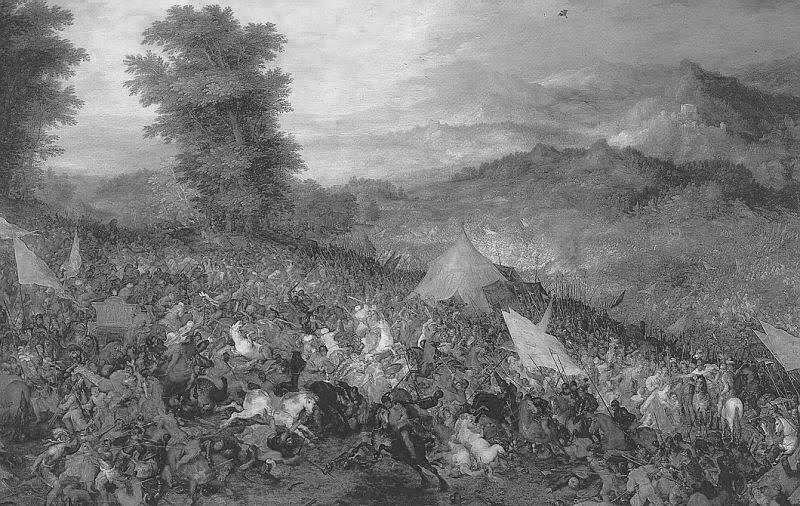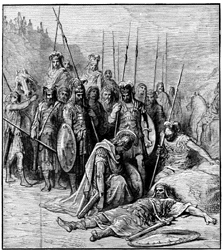|
|
|
 The
Battle of Guagamela
The
Battle of Guagamela

The battle of Gaugamela, 331 BC
While Alexander was invading Tyre, Darius sent him a massager with a proposal: Alexander would get all the land west of the Eufrate, 10,000 talents, and the hand of Darius' daughter, but in return Darius' family had to be reunited, and a permanent alliance between both empires should be signed. Alexander rejected the proposal as everything that Darius offered was in his reach anyway, and he could marry Darius' daughter with or without the approval of her father he said.
Tyre fell in the hands of Alexander and he continued his journey southwards.
Before he could enter Egypt he had to deal with another coastal city called
Gaza. Just like Tyre this city
The stories of Alexander's victories had of course reached Egypt, as well as the rest of the known world, and the Persian satrap in Egypt wisely decided that trying to stop Alexander would be useless. The Persian satrap simply did not have enough men to form an adequate army, so he did not resist the combined Greek-Macedonian invasion. The Egyptians even welcomed Alexander in their land as they finally would get rid of the hated Persians. Alexander was seen as a liberator and made pharaoh. The Egyptian pharaohs were always seen as Gods, so Alexander even more felt like a God. But what finally convinced him that he was a God was an oracle which called him the son of God.
With the conquest of Egypt Alexander secured the homeland from a Persian naval attack, and now it was time to move to the heart of the Persian empire. He moved through Syria, crossed the Euphrates and Tigris and met the Persian army at the other side of Mesopotamia: in the plains of Gaugamela near the city Arbela. For Darius it was now a matter of winning the battle, or his empire would be destroyed by Alexander.
Phase one: attacks of the Persian cavalry
| The Battle of Marathon |
| Persians |
Alexander |
|
Hoplites |
| 4,000 |
31,000 |
|
Cavalry |
| 35,000 |
7,050 |
|
|
| 52,000 |
9,000 |
|
|
| None |
200 Chariots |
Darius had once again proved that he was an excellent organizer. The size and diversity of his army could only be compared to the army of Xerxes during his attack on the mainland of Greece. His men came from all the regions of his vast empire: Scyths, Bactrians, men from numerous small tribes, but also Greek mercenaries. Besides foot soldiers he had chariots, and even 15 war-elephants, but again the biggest part of his army consisted of cavalry. That is why he had ordered his troops to level the battlefield so he could use his cavalry and chariots optimally.
Alexander on his turn had also prepared himself for the battle. He had captured, and interrogated, several Persians and thanks to this information he was able to reconstruct the Persian army. On top of that he sent out several reconnaissance missions, and he was even in charge of one of them, to get as much information as possible about the Persian army. Now he knew how Darius was planning to use his forces, and he placed his army in a sloped formation. A big part of the phalanx was positioned behind the first phalanx as reserves. As a result he did not have enough men to form a strong left wing. It was the job of the cavalry to secure this wing.
The Persian army used a completely different formation: the whole army formed one straight line, within the center the chariots moved a little ahead of the rest, with archers to back them up. Darius wanted to attack the right wing of Alexander's army because there were the most experienced forces. If he could defeat them, the Macedonian-Greek army would surely fall apart and be an easy target he thought. He sent more and more cavalry to his left wing to increase his superior power in that area even more. Alexander saw the danger and knew that he had to do something. He could use his reserve phalanx, but he rather kept them ready to fill up gaps in his formation. Instead he moved his whole army towards the Persian left wing.
Both armies could have continued this for a while, but then they would leave the area which was leveled by Darius for his cavalry. The moment had come to attack and he ordered Bessos to attack with the left wing. Thousands and thousands horsemen charged forwards where they crashed into the right wing of Alexander which consisted of light and heavy cavalry, supported by light forces and archers. Alexander's right wing, under the command of Ariston, had a difficult time in the beginning and was not able to hold position, until a part of the reserve phalanx moved forwards and joined the battle.

Darius saw that the battle at the Greek-Macedonian right wing
had reached a status quo and he ordered his chariots to attack the phalanx. This
way he hoped to create chaos in Alexander's army, thus giving his cavalry a
chance to break through the defenses. Unfortunately were the chariots, just like
during the battle of Cunaxa 70 years earlier, a huge failure. Alexander simply
opened his formation and let the dangerous chariots go through while his light
forces attacked them with all kinds of projectiles.
Phase two: the Macedonian formation breaks
The attack of Bessos on the Greek-Macedonian right wing had created a weak spot in the Persian formation. His cavalry had moved forward for the attack, and the Persian phalanx had to stretch out a bit to keep in contact with the charging cavalry. Alexander was lucky that he had placed his elite heavy cavalry just in front of this spot. He charged forward and ordered his phalanx to attack at the same time. Darius saw that Bessos is not making any progress, and ordered his complete right wing, under the command of Mazaeus, to attack in the hope of overwhelming Alexander with his numeric advantage.

Alexander manages to break through the weak spot with his
cavalry and pursues these fleeing Persian forces. Because of this he moves
forwards and to the left, dragging the attacking phalanx with him as they are
desperate to keep in touch with Alexander because he forms the protection of
their weak right side. At the other side of the battlefield Mazaeus crashes into
the Greek-Macedonian left wing, which is led by Parmenio, and pushes it
backwards. Now the right wing of Alexander is holding its position in a fight
with Bessos, while the center with Alexander himself moves forwards, and the
left wing is being pushed back by Mazaeus. Needless to say that the center of
the phalanx can not move forwards and backwards at the same time, and the
formation of Alexander opens up.
A part of the Indian and Persian heavy cavalry spots this gap, and manages to move through it to the heart of the Greek-Macedonian army: the baggage. They kill the guards and liberate many Persian prisoners of war before the reserve phalanx stops their attack with the help of the light foot soldiers. This Persian attack is stopped, but the gap in the formation still exists and Parmenio is having difficulties keeping the left wing together. He sends a massager after Alexander who immediately stops his pursue of the Persians and turns around.
Alexander wants to move towards the center of the Persian army and attacks it in the back with his cavalry, but he crashes into the retreating Persian cavalry who had attacked the baggage of Alexander's army several minutes before. This way Alexander can not complete his maneuver, and Parmenio must wait a little longer before reinforcements will decrease the pressure on the left wing some. Then the chances suddenly change: Parmenio not only manages to stop the attack of the Persian cavalry, he even manages to push them back with his Thessalian cavalry! The Persians start to retreat in this area of the battlefield, and Alexander can move closer to the center. Darius feels threatened with Alexander and his elite forces so close to him, and decides to flee as fast as he can. The same situation as during the battle of Issus occurs: the remainder of the Persian army (this time the left wing) hears that Darius is leaving the battlefield, and decides to do the same.
The results of the battle
At the moment of Darius' departure was the battle far from decided. Alexander
might have forced an important break-through with his heavy cavalry, but just
like at Issus Darius

(Alexander finds King Darius dead)
Now the way to the heart of the Persian empire was open for Alexander and important cities like Susa, Babylon, and Perspepolis were conquered by him one after the other. Darius became a fugitive in his own country, and was eventually killed in one of the northern provinces by one of his own officers. Alexander declared himself high king of Persia, and executed the murdered Darius according to Persian laws. He had quickly conquered the central provinces, but the eastern provinces in the mountains were much harder. After three years of warfare he finally managed to subject them to his leadership.
The next years Alexander's problems were more of a political than a militaristic nature. As high king of Persia he had despotic power, and slowly he evolved into a despotic and tyrannical person. He executed the son of Parmenius as he suspected him of treachery, and he also killed Parmenius as he was afraid for revenge. On top of this he realized that he could not keep such an enormous empire together if he would not have a good relationship with its inhabitants. He started to dress and act more and more like a Persian in the hope of establishing this relationship, but the result was that he alienated himself from the Greeks and Macedonians.
Finally Alexander moved eastwards and invaded India in 326 BC. Maybe he could not stop his hunger for more conquests, or maybe he wanted to increase his prestige as political leader by more military victories. In India he gained many more victories, but when he had crossed through the Punjab his army revolted for the first and last time: they refused to move any further to the east and wanted to go home. He turned around, and the last part of his expedition through India was more like an exploration. In 324 he arrived in Susa again, and started to make new plans. He wanted to conquer the areas dominated by Carthage, stop the growing power of Rome, and finally conquer the Arabian peninsula. If he would have achieved this he would have conquered the whole known world. Alexander died in 323 because of a fever.
If you have any questions or comments feel free to e-mail me.
Senior Project : 2001-2002 The Great Persian Empire Website